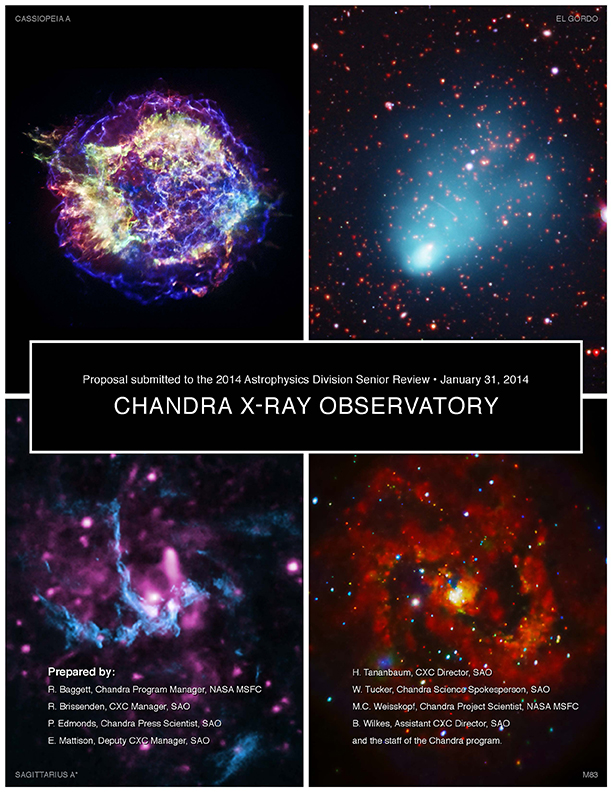Chandra "Enthusiastically Endorsed" for Extension in Senior Review
Peter Edmonds is the Chandra Press Scientist and, in addition to his work on publicizing Chandra science, has been heavily involved with the Chandra's Senior Review proposal since 2008.
In science, "peer review" is used to describe a process that determines whether a research paper should be published in a journal. One or more experts review the paper and determine its fate: are the results and discussion reliable and do they meet the publication standards of the journal?
This process plays a crucial role in advancing scientific research and accordingly it receives a lot of attention, especially in efforts to improve it. However, peer review is just one example, in science, where experts perform reviews. In astronomy there are committees that review telescope proposals and panels that review the performance and determine the fate of entire observatories. NASA's Senior Review is an important example of the latter. Last week the Chandra X-ray Observatory, along with the Hubble Space Telescope (HST) and many other NASA missions, received reports responding to their 2014 Senior Review proposals. We are delighted to report that the Chandra mission received a glowing endorsement.
The goal of Senior Review, according to NASA, is "to maximize the scientific return from these programs within finite resources". In other words, NASA wants to get the most science possible out of their limited budget. Chandra has gone through this process every two years since 2008 and has performed very well each time.

Figure: The cover page of the Chandra proposal to NASA’s Senior Review for 2014. Credit: NASA/CXC.
As with previous years, the 2014 Senior Review proposal included a science section describing research highlights since the last Senior Review and a discussion of likely future results; a technical section describing the status of functions such as mission operations, spacecraft health, data collection and archiving and a detailed budget. This year there was also a two-day long site visit.
The full report on Chandra is available here, including the membership of the expert panel that performed the review. I've picked out a few highlights of the report concerning the quality of Chandra’s scientific accomplishments and our communication efforts in Education and Public Outreach (EPO), and the high demand for Chandra observing time:
"The prospects for further compelling science return in the future are excellent. This panel enthusiastically endorses the extension of the Chandra mission."
"Chandra discoveries continue to have an extraordinarily high impact on both the scientific and public understanding of our universe."
"The vast breadth of Chandra science reaches almost every area of astrophysics, including star and galaxy formation, the creation of the elements, the origin and evolution of black holes and galaxies and placing stellar activity in a cosmic context."
"The large number of Chandra proposals (636 in Cycle 16 in March 2014) indicates a very high demand for observing time, archival research and theoretical studies. Many proposals investigate new ideas that were not even imagined before launch. Many exciting results published in refereed journals are released to the public as press releases (~30 per year) with excellent illustrations that have high visibility in the media."
"The Panel recognizes the clear importance of communicating Chandra’s scientific results beyond the scientific community. The CXC staff members are to be commended for the extraordinary innovative methods and techniques they have employed in publicizing Chandra science and engaging the broader public."
These positive comments are gratifying for everyone associated with the Chandra mission, especially the many people who worked very hard on the Senior Review proposal, including several members of our EPO group.
The panel also listed six findings “that may be useful to enhance future returns from the observatory”, as listed in the Executive Summary and section seven of the report.
I'll note that a great deal of research performed with Chandra involves combining results with other observatories, both in space and on the ground. Therefore, I’d like to congratulate our Great Observatory cousins at Space Telescope Science Institute for the very positive report from Senior Review on HST, and our colleagues at other endorsed missions.
For more information about Senior Review, the Call for Proposals and the response by NASA to the Senior Review report are both publicly available.
-Peter Edmonds, CXC
Please note this is a moderated blog. No pornography, spam, profanity or discriminatory remarks are allowed. No personal attacks are allowed. Users should stay on topic to keep it relevant for the readers.
Read the privacy statement
